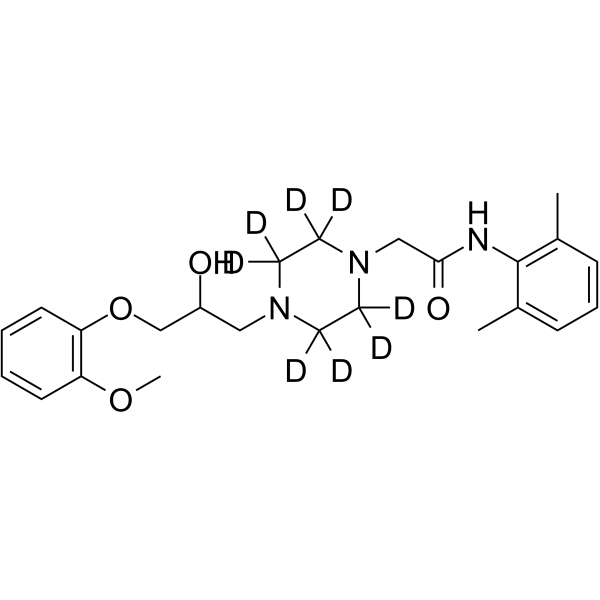Ranolazine-d8
Modify Date: 2024-07-03 18:33:27

Ranolazine-d8 structure
|
Common Name | Ranolazine-d8 | ||
|---|---|---|---|---|
| CAS Number | 1092804-88-0 | Molecular Weight | 435.59 | |
| Density | N/A | Boiling Point | N/A | |
| Molecular Formula | C24H25D8N3O4 | Melting Point | N/A | |
| MSDS | N/A | Flash Point | N/A | |
Use of Ranolazine-d8Ranolazine-d8 (CVT 303-d8) is the deuterium labeled Ranolazine. Ranolazine (CVT 303) is an anti-angina drug that achieves its effects by inhibiting the late phase of inward sodium current (INa and IKr with IC50 values of 6 μM and 12 μM, respectively) without affecting heart rate or blood pressure (BP)[1][2]. Ranolazine is also a partial fatty acid oxidation (FAO) inhibitor[3]. Antianginal agent. |
| Name | Ranolazine-d8 |
|---|
| Description | Ranolazine-d8 (CVT 303-d8) is the deuterium labeled Ranolazine. Ranolazine (CVT 303) is an anti-angina drug that achieves its effects by inhibiting the late phase of inward sodium current (INa and IKr with IC50 values of 6 μM and 12 μM, respectively) without affecting heart rate or blood pressure (BP)[1][2]. Ranolazine is also a partial fatty acid oxidation (FAO) inhibitor[3]. Antianginal agent. |
|---|---|
| Related Catalog | |
| In Vitro | Stable heavy isotopes of hydrogen, carbon, and other elements have been incorporated into drug molecules, largely as tracers for quantitation during the drug development process. Deuteration has gained attention because of its potential to affect the pharmacokinetic and metabolic profiles of drugs[1]. |
| References |
| Molecular Formula | C24H25D8N3O4 |
|---|---|
| Molecular Weight | 435.59 |